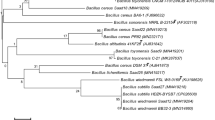Abstract
Soil samples were taken from paddy rice fields in 14 provinces in the southern part of Thailand. Bacteria were isolated from these soils using the soil dilution plate method on King’s B medium and Thornton’s standardised medium. Isolation yielded 323 bacterial isolates which were subsequently tested for their effectiveness in inhibiting mycelial growth of Rhizoctonia solani, the causal agent of sheath blight of rice. Eight isolates were selected for their ability to create a clear zone in a dual culture test. Further tests evaluated the effect of selected bacteria on sclerotial germination and subsequent mycelial growth, and also on the development of sheath blight lesions on excised rice stems. Three bacterial isolates (16,26 and 29) provided the greatest inhibition of sclerotial germination and mycelial growth and maximum suppression of sheath blight lesions. Isolate 26 and subsequently isolate 29 were chosen for formulation studies. Granulated formulations of these bacterial isolates were developed using the wet granulation technique. The main components of these bacterial formulations were bacterial cells, hydrogenated vegetable oil, monohydrate lactose, polyvinyl pyrrolidone, and crosslinked sodium carboxymethyl cellulose. The efficacy of the formulation of isolate 29 in suppressing sheath blight symptoms was similar to that of fresh cells of isolate 29.
Similar content being viewed by others
References
Chin, K.M. and Bhandhufalck, A. (1990) — The importance of crop growth stages for determining the application timing of disease control agents on rice. In Pest Management in Rice (Eds B.T. Grayson, M.B. Green and L.G. Copping), pp. 131–142. Elsevier Applied Science, London, New York.
Cook, R.J. (1993) — Making greater use of introduced microorganisms for biological control of plant pathogens. Annual Review of Phytopathology 31: 53–80.
Dodman, R.L. (1970) — Factors affecting the prepenetration phase of infection by Rhizoctonia solani. In Root Diseases and Soil-borne Pathogens (Eds T.A. Toussoun, R.V. Bega and P.E. Nelson), pp 116–121. University of California Press, Berkeley,
Gnanamanickam, S.S. and Mew, T.W. (1990) — Biological control of rice disease (Blast and Sheath blight) with bacterial antagonists: An alternative strategy for disease management. In PestManagement in Rice (Eds B.T. Grayson, M.B. Green and L.G. Copping), pp. 87–110. Elsevier Applied Science, London, New York.
Gnanamanickam, S.S., Candole, B.L. and Mew, T.W. (1992) — Influence of soil factors and cultural practice on biological control of sheath blight of rice with antagonistic bacteria. Plant and Soil 144: 67–75.
Groth, D.E., Rush, M.C. and Lindberg, G.D. (1990) — Foliar fungicides for control of rice diseases in the United States. In Pest Management in Rice (Eds B. T. Grayson, M.B. Green and L.G. Copping), pp. 31–52. Elsevier Applied Science, London, New York.
Johnson, L.F. and Curl, E.A. (1972) — Methods for Research on the Ecology of soil-borne Plant Pathogens. Burgess Publishing Company, Minnesota.
Kloepper, J.W. (1991) — Development of in vivo assays for prescreening antagonists of Rhizoctonia solani on cotton. Phytopathology 81: 1006- 1013.
Lee, F.N. and Rush, M.C. (1983) — Rice sheath blight: A major rice disease. Plant Disease 67: 829–832.
Lennette, E.H. (1985) — Manual of Clinical Microbiology. Fourth Edition. American Society for Microbiology, Washington D.C.
Lewis, J.A. (1991) — Formulation and delivery systems of biocontrol agents with emphasis on fungi. In The Rhizosphere and Plant Growth (Eds D.L. Keister and P.B. Cregan), pp. 279–287. Kluwer Academic Publishers, The Netherlands.
Mac Faddin, J.F. (1976) — Biochemical Tests for Identtification of Medical Bacteria. The Williams & Wilkins Company, Baltimore.
McIntyre, J.L. and Press, L.S. (1991) — Formulation, delivery systems and marketing of biocontrol agents and plant growth promoting rhiiobacteria (PGPR). In The Rhizosphere and Plant Growth (Eds D.L. Keister and P.B. Cregan), pp. 289–295. Kluwer Academic Publishers, The Netherlands.
Mew, T. W. and Rosales, A.M. (1986) — Bacterization of rice plants for control of sheath blight caused by Rhizoctonia solani. Phytopathology 76: 1260–1264.
Ou, S.H. (1985) — Rice Diseases. Second Edition. Commonwealth Mycological Institute, Kew, Surrey.
Polon, J.A. (1973) — Formulation of pesticidal dusts, wettable powders and granules. In Pesticide Fonnulation (Ed W. Van Valkenburg), pp. 143–234. New York, Marcel Dekker.
Reissig, W.H., Heinrichs, E.A., Litsinger, J.A., Moody, K., Fielder, L., Mew, T.W., and Bamon, A.T. (1986) — Illustrated Guide to Zntegrated Pest Management in Rice in Tropical Asia. International Rice Research Institute, Los Banos, Laguna, Philippines.
Schaad, N.W. (1980) — Initial identification of common genera. In Laboratory Guide for Identification of plant Pathogenic Bacteria. (Ed N.W. Schaad), pp. 1–11. The American Phytopathological Society, St. Paul, Minnesota.
Teng, P.S., Torres, C.Q., Nuque, F.L., and Calvero, S.B. (1990) — Current knowledge on crop losses in tropical rice. In Crop Loss Assessment in Rice. Intemational Rice Research Institute, Manila, Philippines. pp. 39–53.
Vasantha Devi, T.V., Malar Vizhi, R., Sakthivel, N. and Gnanamanickam, S.S. (1989) — Biological control of sheath blight of rice in India with antagonistic bacteria. Plant and soil 119: 325–330.
Zuberer, D.A. (1994) — Recovery and enumeration of viable bacteria. In Methods of Soil Analysis: Microbiological and Biochemical Properties (Eds R.W. Weaver, S. Angle, P. Bottomley, D. Bezdicek, S. Smith, A. Tabatabai and A. Wollum), pp. 119–143. Soil Science Society of America, Wisconsin.
Author information
Authors and Affiliations
Corresponding author
Additional information
An erratum to this article is available at http://dx.doi.org/10.1007/BF03213728.
Rights and permissions
About this article
Cite this article
Kanjanamaneesathian, M., Kusonwiriyawong, C., Pengnoo, A. et al. Screening of potential bacterial antagonists for control of sheath blight in rice and development of suitable bacterial formulations for effective application. Australasian Plant Pathology 27, 198–206 (1998). https://doi.org/10.1071/AP98022
Received:
Accepted:
Issue Date:
DOI: https://doi.org/10.1071/AP98022




